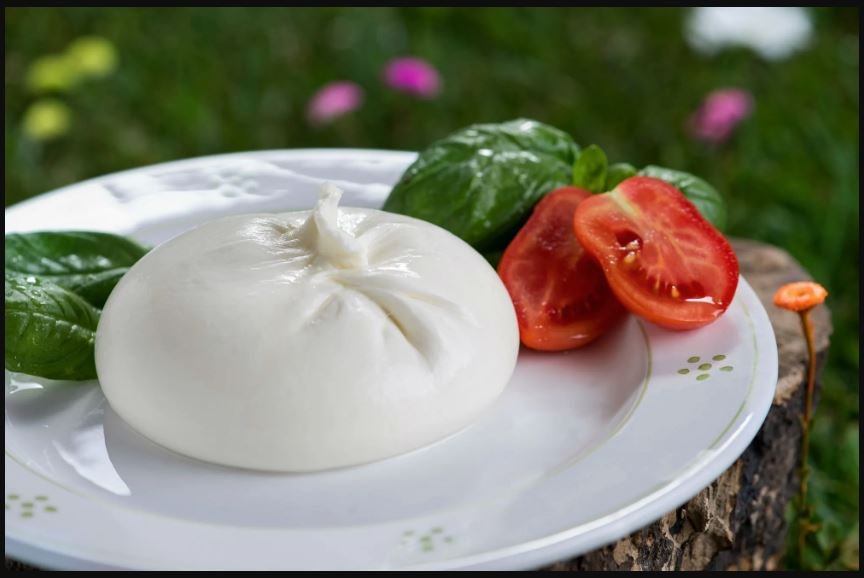Burrata cheese is not just any cheese; it’s a creamy delight that takes your culinary experience to another level.
Picture this: a delicate outer shell made of mozzarella cradling an indulgent, gooey center that oozes with rich cream and fresh curds.
Just the thought makes your mouth water. From Italy’s ApulItaly’son, Burrata has charmed its way into kitchens and heartstrings worldwide.
Whether you’re a lonyou’refan or new to this luscious treat, there’s discover about burrata cheese—from its fascinating history and unique making process to delicious ways to enjoy it.
Get ready to dive deep into everything, Burrata!
What is Burrata Cheese?
Burrata cheese is a fresh, artisanal creation that offers an irresistible combination of textures and flavors. At first glance, it resembles mozzarella with its smooth, white exterior.
However, the magic lies within. When you cut into Burrata, a creamy filling flows out—this is where the richness unfolds. The inner mixture consists of stracciatella and cream, creating a delightful contrast to the firmer outer shell.
This Italian delicacy has earned its place in gourmet kitchens around the globe. It’s celebraIt’sfor its mild flavor profile, which pairs beautifully with various ingredients, from ripe tomatoes to fragrant basil.
Often served at room temperature, Burrata invites you to savor every bite. Whether enjoyed on a charcuterie board or as part of an elegant salad, this cheese transforms simple dishes into culinary masterpieces. Its unique character makes it truly special in the world of cheeses.
The History and Origin of Burrata Cheese
Burrata cheese has a captivating history that traces back to the southern Italian region of Apulia. It emerged in the late 19th century as a way for cheesemakers to utilize leftover scraps from mozzarella production.
The name “burrata” me”ns “but”ered” i” Italian” reflecting its creamy interior filled with fresh cream and stracciatella. This rich filling is encased within an outer layer of mozzarella, creating a delightful contrast of textures.
Legend states that the monks first created Burrata at a small farm near Andria. They sought to make cheese more indulgent during harsh winters, leading to this luxurious innovation.
As global interest grew, Burrata fled beyond Italy’s bordItaly’sbordItaly’s celebrated world for its unique taste and versatile culinary applications. Its creamy goodness continues to enchant food lovers everywhere.
How is Burrata Cheese Made?
Burrata cheese begins with fresh mozzarella crafted from cow’s milk. The process starts by heating the milk and adding rennet to curdle it. Once the curds form, they are cut and gently cooked.
Next, skilled artisans knead the curds until they become smooth and stretchy. This is where the magic happens—some of this mozzarella is set aside for later use as a shell.
The remaining mozzarella is combined with rich cream to create a luscious filling. This mixture brings that signature creamy texture we love.
Afterward, the outer layer of mozzarella is shaped into a pouch, carefully enveloping that velvety cream interior. It’s sealed off and submerged in salted water or whey to maintain freshness before it reaches your table. Each step requires precision and skill—a true labor of love!
Types of Burrata Cheese
Burrata cheese comes in various styles, each offering a unique palate experience. Traditional Burrata is made with cow’s milk and featcow’sa creamy center encased in mozzarella.
You might encounter truffle burrata infused with aromatic truffle oil. This version adds an earthy depth, perfect for gourmet dishes.
Then there’s smoke, and their subtle smokiness enhances salads or charcuterie boards. Its flavor profile makes it versatile for both savory and sweet pairings.
For those seeking something different, herb-infused options like basil or garlic are available. These varieties bring fresh notes to any dish while maintaining the signature creaminess of the classic Burrata.
There are vegan alternatives available on the market today. Made from nuts or soy, these options aim to replicate the texture without dairy products but still deliver delightful flavors suitable for plant-based diets.
How to Choose the Best Burrata Cheese?
When choosing the best burrata cheese, freshness is key. Always look for a product with a recent production date. The fresher the Burrata, the creamier and more flavorful it will be.
Texture matters, too. A good burrata should feel soft and slightly yield to pressure. If it’s too firm, it may have lost its moisture content.
Next, consider the packaging. Authentic Burrata is often sold in water or whey to maintain its delicate nature. Avoid any that appear dry or discolored.
Don’t forget to check don’t quality certifications if available. Artisan producers typically offer superior flavors compared to mass-produced varieties.
Trust your taste buds! Sample different brands when possible and find one that resonates with your palate—each bite should be a delightful experience without overwhelming richness.
Delicious ways to enjoy Burrata Cheese
Burrata cheese is a versatile delight that elevates any dish. Start with a classic caprese salad. Layer slices of fresh tomatoes, basil, and creamy Burrata for a refreshing appetizer.
For something heartier, try it on pizza. The gooey texture beautifully complements the rich tomato sauce. Add it during the last few minutes of baking to achieve melty perfection.
A unique option is pairing Burrata with grilled peaches. The fruit’s sweetness wonderfully balances the creaminess. Drizzle some balsamic reduction for an extra kick.
Don’t forget about bDon’tast! Spread Burrata on toast with avocado and poached eggs for a luxurious morning treat.
Mix it into pasta dishes or risotto for added creaminess and flavor depth. Each bite becomes a little celebration of taste and texture you won’t want to miss.
won’t-natives to Burrata Cheese
If you’re looking for ayou’retives to burrata cheese, several delicious options are worth exploring.
Mozzarella is the closest substitute. It maintains a similar texture and mild flavor. Fresh mozzarella can bring that creamy satisfaction to your dishes.
Another option is stracciatella, which is part of the Burrata itself. This soft, cream-filled cheese has a delightful richness and can elevate salads or pasta.
Ricotta also works well in place of Burrata. Its smoothness adds a wonderful touch to various recipes, especially desserts or spreads.
For those seeking vegan alternatives, cashew-based cheeses provide creamy textures without dairy. They can be seasoned to mimic the flavor profile of traditional cheeses.
Goat cheese offers tanginess that contrasts nicely with sweet fruits or honey drizzles. Each choice brings unique character while satisfying cravings for something rich and indulgent.
Conclusion
Burrata cheese is more than just a culinary delight; it’s an experience that captures the essence of authentic Italian cuisine. From its rich history to the intricate process of making it, every aspect adds to its allure.
With various types available and numerous ways to enjoy it, there’s no shortage of creativity when incorporating Burrata into your meals.
When selecting Burrata, remember that freshness is key. The best varieties often come from small producers who prioritize quality over quantity. Whether drizzling olive oil on a simple salad or pairing it with charcuterie, Burrata elevates any dish.
If you can’t find burrata in the local market, fear not! Several alternatives can bring similar flavors and textures to your table.
Embrace the versatility and indulgence of this creamy cheese as you explore different recipes and pairings. Each bite offers a taste of tradition while inspiring new culinary adventures.


